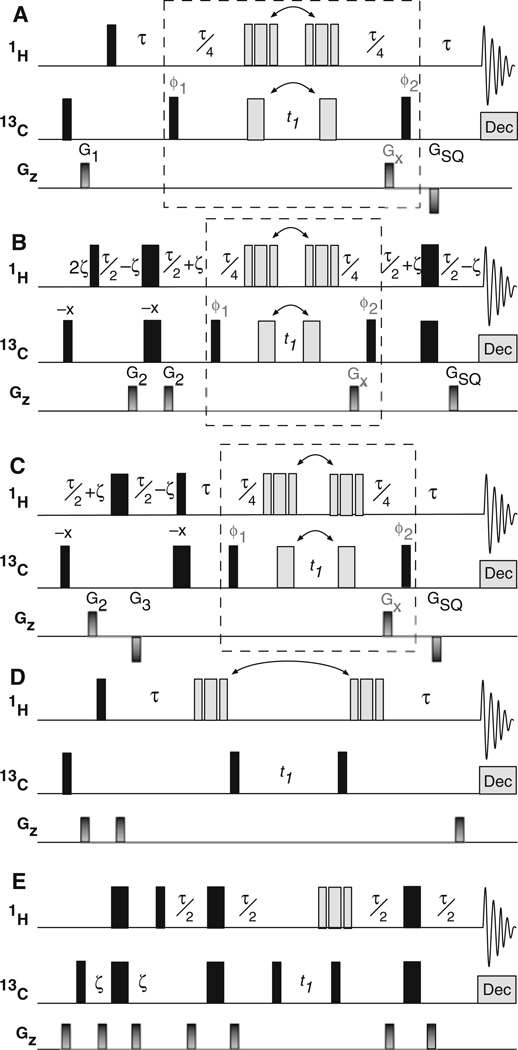Fig. 1.
Comparison of gradient selected pulse sequences for measuring 1H–13C heteronuclear zero-quantum coherences (gsHZQC) to previously proposed HZQC schemes (Tugarinov et al. 2004; Ollerenshaw et al. 2005). a A simple implementation of the gsHZQC experiment. The dashed box denotes four distinct parts of the pulse sequence: two for inversion of the outer multiplet components and two for echo/antiecho frequency discrimination during t1. These alterations are achieved by a pulse sequence element in which the positions of the composite 1H (90x–180y–90x) and 180° 13C pulses flanking t1 (gray bars) are shifted (see Fig. 2). The phases φ1 and φ2 are given in Fig. 2 for the first step of the phase cycle. The 90° 13C pulse labeled φ1 and the receiver are inverted on alternate scans for isotope filtration. All other pulse phases are {x}. Weak presaturation was used to suppress the water resonance. WALTZ-16 (Shaka et al. 1983) was used for 13C decoupling during t2. G1 = (1 ms, 7 G/cm), GSQ = (500 µs, −22.5 G/cm), GZQ = (500 µs, 30 G/cm), GDQ = (500 µs, 18 G/cm), and τ = 1/(2JCH) ≈ 3.91 ms. b and c gsHZQC pulse sequences with signal enhancement using natural 13C polarization. The pulse train for 13C begins on {−x} and inverts with the isotope filter. G2 = (500 µs, 5 G/cm), G3 = (500 µs, −5 G/cm) and 2ζ = 1.5 ms (corresponding to sin(2πJCHζ) = 3−1/2). For (B), GSQ = (500 µs, 22.5 G/cm). Pulse sequences and parameter sets suitable for Bruker spectrometers are provided for (a–c) in supplementary material. d Previous HZQC pulse sequence by Tugarinov and coworkers (Tugarinov et al. 2004) that utilizes 1H magnetization and differential relaxation rates to eliminate signal from outer multiplet components. e An unfiltered HZQC experiment by Ollerenshaw and coworkers (Ollerenshaw et al. 2005) that includes 13C polarization enhancement. The delays, τ and ζ, are the same as in (a) and (b), respectively. Gradient strengths and pulse phases for (d) and (e) are as described previously (Tugarinov et al. 2004; Ollerenshaw et al. 2005)

